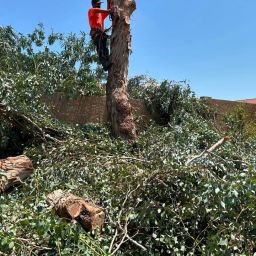
If you’ve been wondering how to trim a Bengal tree in Burlington, WA, you’re not alone. A lot of us in the Burlington and greater Skagit County area have these gorgeous trees in our yards or homes, and knowing how to care for them is essential. The thing is, trimming a Bengal tree (also known as a Ficus Benghalensis) isn’t just about grabbing some shears and cutting away. There’s a method to the madness, especially if you want your tree to stay healthy and look its best.
Here in Burlington, where our weather can be a little tricky—cooler winters, moist springs, and sometimes dry summers—it’s essential to understand how to prune and care for trees like this in a way that matches our local climate. At Baxter’s Tree Service, we’ve helped tons of Burlington homeowners with their tree trimming needs, and today, I’m going to walk you through how to give your Bengal tree the care it deserves.
Why Trimming Your Bengal Tree in Burlington, WA, is Important
Bengal trees, like many types of ficus, can grow pretty large, and without regular pruning, they can become unruly. Not to mention, improper trimming can weaken the tree, cause irregular growth, or even invite disease. When you ask, how to trim a Bengal tree in Burlington, WA, you’re really asking, “How do I keep my tree healthy and beautiful in our unique climate?”
Whether it’s a large outdoor ficus or a smaller indoor variety, the timing and technique of trimming are crucial. Regular trimming will help:
- Encourage healthy growth
- Maintain the shape of the tree
- Prevent overgrowth and crowding
- Remove dead or diseased branches
Here in Burlington, where our trees face varying weather conditions throughout the year, it’s even more important to stay on top of pruning.
Related Article: How much does it cost to trim a tree in Burlington, WA?
The Best Time to Prune Your Ficus Tree in Burlington
Now that you know why pruning is important, let’s talk about when you should get the job done. Generally, the best time to prune ficus trees, including Bengal trees, is in the late winter or early spring, right before new growth begins. This is when the tree is still dormant, and pruning won’t stress it out as much. It’s also a good time because you’ll be able to see the structure of the tree better without all the leaves in the way.
For outdoor ficus trees in Burlington, like those in the Skagit Valley, late winter is ideal because it gives the tree enough time to recover before the growing season kicks in. Indoor ficus trees, like Ficus Elastica or Ficus Audrey, can be pruned year-round, but it’s still better to avoid doing so during active growth periods.
How to Trim a Large Outdoor Ficus Tree in Burlington, WA
If you’re dealing with a large ficus tree outdoors, the process is a bit different than trimming an indoor potted tree. Outdoor ficus trees, like those in front yards or near driveways in Burlington, need careful attention because of their size.
Steps for Trimming a Large Outdoor Ficus:
- Assess the Tree: Before you make any cuts, look over your tree carefully. Identify any dead, damaged, or diseased branches that need to go first. These are easy to spot because they won’t have leaves or may appear discolored.
- Start With the Dead and Damaged: Always remove dead or damaged branches first. This ensures that the tree’s energy goes toward healthy growth. Use clean, sharp pruning shears or a saw for thicker branches.
- Shape the Tree: Once the dead branches are removed, step back and look at the tree’s shape. You want a nice, balanced look. Cut back any overgrown branches that are crossing over or rubbing against each other.
- Prune to Encourage Growth: If you want your tree to grow bushier, cut just above a node (where a leaf or branch grows). This will encourage new branches to form there.
- Hard Pruning for Overgrown Trees: If your ficus has gotten out of control, you may need to do a hard prune. This involves cutting the tree back significantly to manage its size and shape. It sounds harsh, but with the right care, the tree will bounce back.
Also Read: How to trim growth from palm trees in Burlington, WA?
Indoor Banyan Tree Care and Pruning Tips for Burlington, WA
Indoor ficus trees, such as the popular Ficus Elastica (Rubber Plant) or Ficus Audrey, are a little different when it comes to pruning. They don’t require as much work as outdoor ficus trees, but they still benefit from occasional pruning to keep them healthy.
How to Prune Indoor Ficus Trees:
- Keep it Simple: You don’t need to go overboard. Just trim back any leggy growth, cut away dead leaves, and shape the tree to your liking.
- Watch for Pests: Indoor ficus trees can sometimes attract pests like spider mites or mealybugs, especially during winter when the air is dry. Pruning can help you spot infestations early and manage them.
- Use Clean Tools: Always make sure your pruning shears are sharp and clean to avoid spreading disease.
How to Make a Ficus Tree Bushy
Whether your ficus is indoors or outdoors, making it bushier is all about how you prune it. Regular trimming will encourage your ficus tree to grow fuller, especially if you cut just above the nodes. Additionally, giving your tree enough sunlight and the right amount of water will help promote healthy growth.
In Burlington, where we don’t always get the sunniest weather, it’s crucial to position your ficus in a spot where it can soak up as much natural light as possible.
How to Prune Ficus Elastica and Ficus Audrey in Burlington, WA
Both Ficus Elastica (Rubber Plant) and Ficus Audrey are popular indoor ficus varieties here in Burlington. Pruning these trees is relatively easy:
- For Ficus Elastica: Prune to control height and shape. Rubber plants can grow quite tall, so cutting back the top can help you keep it manageable.
- For Ficus Audrey: This tree grows slower, but pruning will help it maintain a nice shape. Focus on trimming back any leggy branches to encourage a fuller look.
How to Trim a Ficus Tree – Video Resources
If you’re a visual learner and want to see how it’s done, there are plenty of how to trim a ficus tree videos and tutorials available on YouTube. These videos can walk you through the process step by step, especially if you’re tackling a hard prune or working with a large tree.
Conclusion: Trust Baxter’s Tree Service for Your Ficus and Bengal Tree Pruning in Burlington, WA
Trimming ficus trees, especially Bengal or other large varieties, can be tricky, but it’s not impossible if you follow the right steps. However, if you’re unsure or want to ensure your trees stay in top condition, why not let the experts handle it?
At Baxter’s Tree Service, we’ve got years of experience working with all types of trees in the Burlington area, including ficus varieties. Whether you’ve got a large outdoor ficus in need of a hard prune or an indoor Rubber Plant that’s getting a little leggy, we’re here to help. Contact us today, and let’s keep your trees looking great all year long.
Frequently Asked Questions (FAQs)
How to Trim a Bengal Tree in Burlington, WA?
To trim a Bengal tree, first remove any dead or damaged branches. Then, shape the tree by cutting back any overgrown areas and encourage new growth by trimming above nodes.
Can I Trim My Ficus Tree?
Yes, you can trim your ficus tree. Regular pruning helps maintain its shape, encourages growth, and removes any damaged or dead branches.
How to Trim a Banyan Tree in Burlington WA?
Pruning a banyan tree involves removing dead or damaged branches first, then shaping the tree by cutting back overgrown areas and ensuring a balanced look.
How to Make a Ficus Tree Bushy?
To make a ficus tree bushy, trim just above the nodes to encourage new branches to grow. Regular pruning and ensuring the tree gets plenty of sunlight will also help.
How to Trim a Weeping Fig Tree in Burlington WA?
Trim a weeping fig by cutting back any dead or damaged branches and shaping the tree for a fuller look. Focus on pruning leggy growth to encourage bushier growth.








